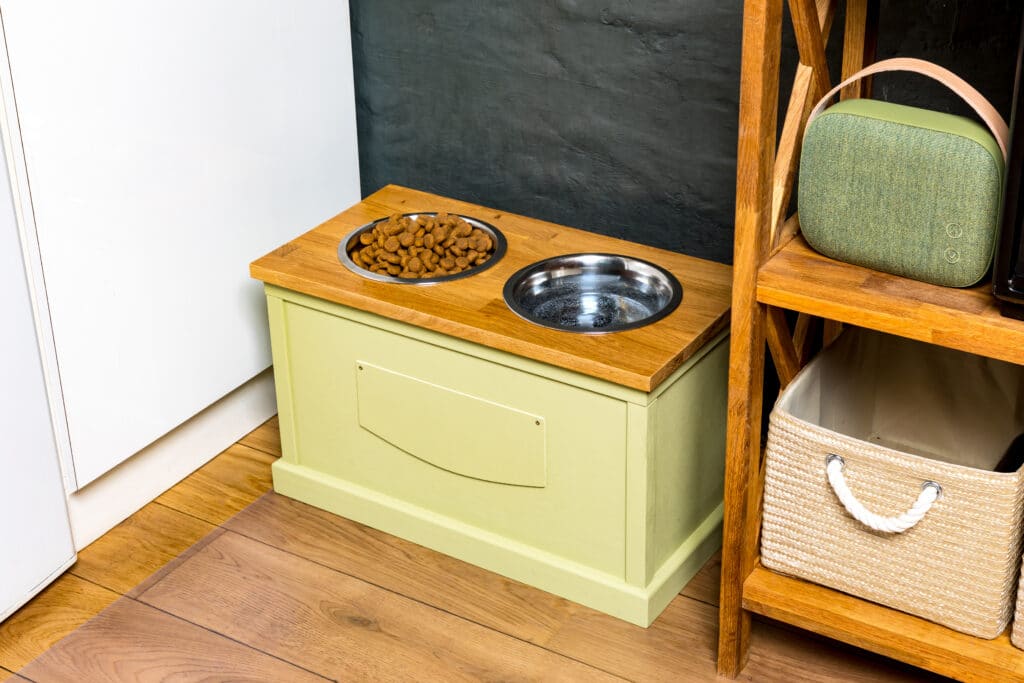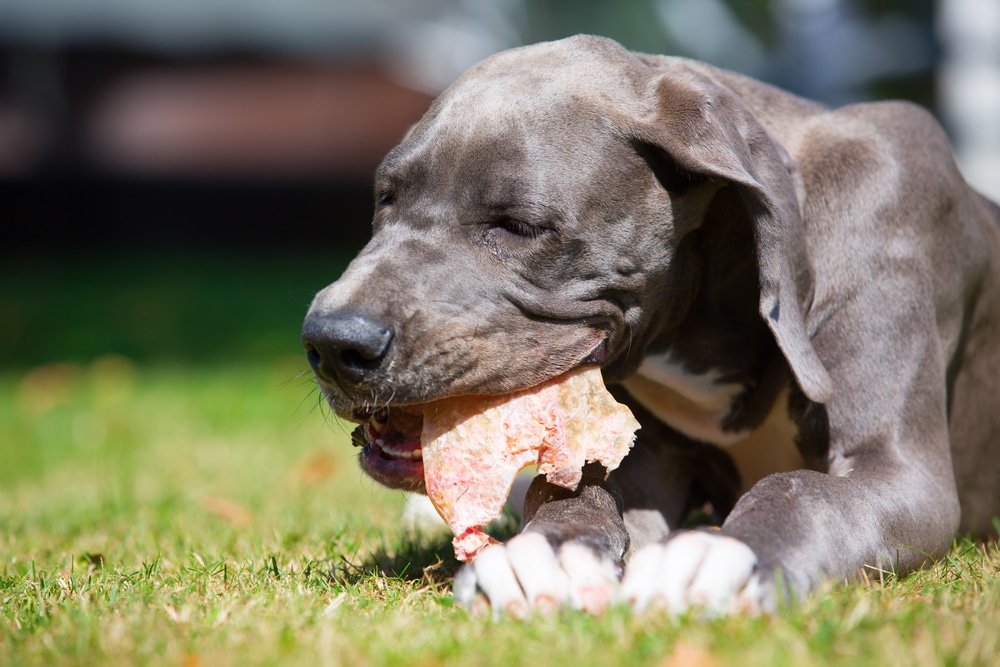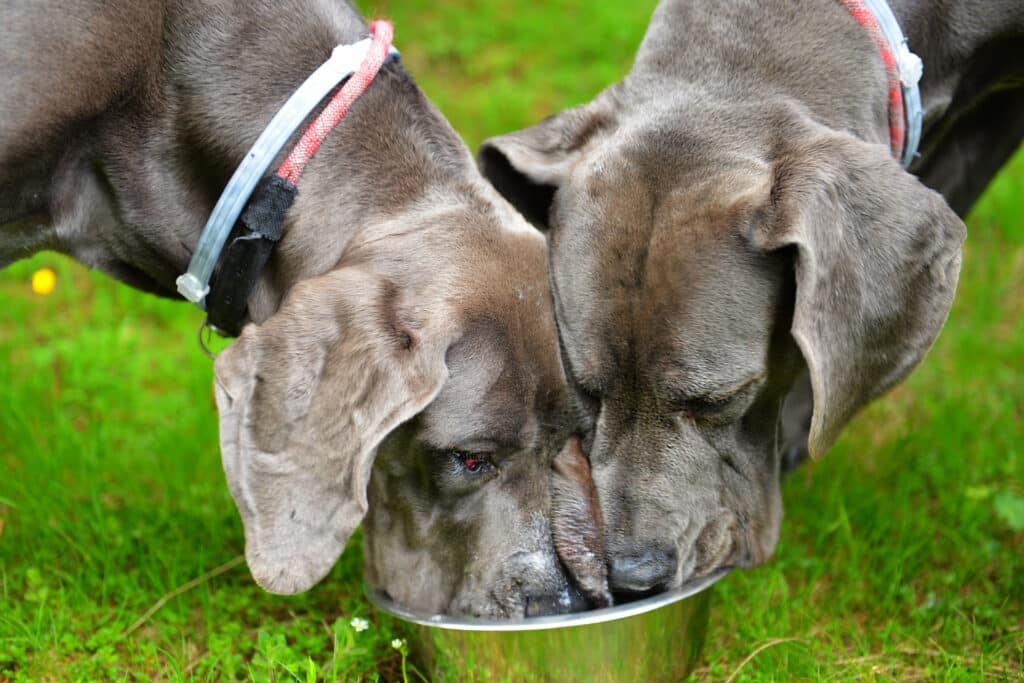“This post contains affiliate links, and I will be compensated if you make a purchase after clicking on my links.”
Last Updated on May 1, 2024
The idea of elevated dog feeders is that they put the food in a more comfortable position for large to giant dog breeds, making it easier for dogs like Great Danes to eat.
But is it really a good idea to use an elevated dog feeder for a breed that is prone to bloat, like Great Danes? This has been an ongoing debate among Great Dane dog owners and breeders.
In this article, we’ll discuss if and when are elevated dog feeders needed by a giant breed like the Great Dane. Continue reading to find out more!
The Use Of Elevated Dog Feeders

Elevated dog feeders are pretty self-explanatory. They are dog feeders that are raised from the ground and are usually housed in some type of stand.
Generally, elevated dog feeders are not a necessity when feeding your dogs. However, they became popular because they looked more comfortable to eat from, instead of a plate on the floor.
Furthermore, the use of elevated dog feeders keep the eating area clean, organized, and makes feeding a lot easier.
The Possible Benefits Of Elevated Dog Feeders
Here are some of the possible benefits of using elevated feeders when feeding your dog:
- They promote better posture for your dog when they’re eating. Bending down while eating, especially for large dogs, can be straining for their necks and joints.
- There is less mess when you use elevated dog feeders. They help reduce water spills and messes on the floor — a particular benefit for dogs considered as messy eaters.
- They help minimize arthritis symptoms. Like us humans, arthritis is a problem for dogs, and we know how painful it can be. With elevated dog feeders, dogs, especially old ones, can eat comfortably, helping reduce the symptoms of arthritis.
- They can aid with post-operative care. Dogs that undergo surgeries can have limited mobility, That means, bending down to eat from the floor can be uncomfortable. So, while dogs recover from their treatment, eating from a comfortable height (with the use of elevated dog feeders) can help with their recovery.
Should Great Danes Eat From Elevated Dog Feeders?
It depends. Generally, eating from an elevated dog feeder is a big no for a breed like the Great Dane. However, if your Great Dane is a senior dog or is suffering from any orthopedic conditions, then they may benefit from eating from an elevated dog feeder.

Elevated dog feeders aren’t totally bad for Great Danes and can actually be beneficial in certain circumstances, such as:
- When your Great Dane is already a senior dog and has limited mobility.
- When your Great Dane has arthritis.
- When your Great Dane suffers from joint pain.
- When your Great Dane suffers or is diagnosed with spinal problems or other orthopedic conditions.
Given the prevalence of orthopedic diseases in large dog breeds, where bending over can be very painful when eating and drinking, many find elevated dog feeders good for their dogs.
Ultimately, if your dog is suffering from any orthopedic conditions, you can discuss the use of an elevated dog feeder with your dog’s vet.
The Problem With Elevated Dog Feeders
In the late 1990s, a team of researchers found out that approximately 20 to 52% of bloat cases in large and giant dog breeds were linked to eating from elevated dog feeders.
This is because elevated dog feeders increase the speed at which a Great Dane eats. And if a Great Dane eats rapidly, the risk of them developing a serious and life-threatening health problem called bloat becomes higher.
While anecdotal evidence suggest that elevated dog feeders help reduce the risk of bloat, another research found out that raising the height of food and water bowls actually increases the risk of bloat by 110 percent.
And although Great Danes can develop bloat due to other factors, keeping your dog’s food and water bowls lower or on the floor is the most common, basic, and regular way to prevent this dangerous medical condition.
Bloat In Great Danes

Bloat is when a dog’s stomach fills with gas, food, or fluid. When not treated immediately, develops to Gastric Dilation and Volvulus or GDV.
When bloat develops to GDV, the stomach twists in itself, blocking the entrance and exit of the stomach, and also stopping blood circulation to other important organs, such as the heart.
How Common Is Bloat In Great Danes?
Bloat is very common in Great Danes. As a matter of fact, Great Danes are the #1 breed that are most prone to it.
A Great Dane’s high risk to it is attributed to their large size and their deep chests. Furthermore, researches have shown that an estimate of 42% of the breed develop this condition during their lifetime, and 13% die of it.
Risk Factors Leading To Bloat
The exact cause of bloat is unknown. However, the use of elevated dog feeders is not the only factor that contributes to the development of bloat. There are also a number of risk factors that contribute to bloat, and they’re the following:
- Age
- A deep chest
- Being too lean
- Bloat occurrence in immediate family
- Eating a large amount of food from a single meal
- Eating rapidly
- Stress and anxiety
1. Age
Older Great Danes are at a higher risk of getting bloat. According to Purdue, the risk of bloat is more than twice as high in dogs that are about seven to nine years old as in dogs that are younger (two to three years old).
Furthermore, the risk becomes three times higher in dogs that are 10 years old and older.
2. Body Proportion And Physique
A dog’s body proportion and physique can also contribute to the development of bloat. As mentioned above, a Great Dane’s size and deep, narrow chest are all contributing factor to their risk to bloat.
Having a deep, narrow chest means Great Danes have more “extra” room in their chests. So, it’s a lot easier for gas to fill in the stomach. This is also true for other deep-chested dogs such as Boxers and Saint Bernards.
Leanness is another contributing factor. Researchers hypothesized that this is because fat takes up space in the abdomen. And without it, gas can easily take up that space and allow the stomach to easily twist on itself.
So, for a lean Great Dane, the lack of fat in the abdomen in addition to their deep chest is a recipe for disaster.
3. Family History
Research has shown that Great Danes with close relatives (like their parent or sibling) who suffered bloat are more susceptible to developing bloat than those Great Danes who has no family history of the condition.
4. Eating Rapidly
Generally, Great Danes are known to eat very fast. And because of this, they are at a higher risk of developing bloat.
This is actually backed by the research performed at the University of Utrecht in the Netherlands . In 1987, Drs. Van Sluijs and Wolvekamp explained how six giant breed dogs with many (3-10) episodes of bloat or gastric dilatation had developed the habit of gulping air down while eating.
Swallowing air (aerophagia) has long been suspected as a risk factor for acute bloat, but since acute bloat strikes without warning, it can be very difficult to demonstrate a relationship.
5. Stress and anxiety
Nervous, excited, stressed, and anxious dogs are at more risk to experience bloat as compared to relaxed and composed dogs.
Tips To Help Reduce Bloat In Great Danes

Here are a few tips to help reduce the risk of bloat in your Great Dane:
- Teach your dog to relax and be calm if it want to be fed. Also, it might be a good idea to feed your dog alone to calm them down. Excited or nervous dogs usually devour their food.
- Consider upgrading their diet. Feeding your Great Dane dry dog food or kibble exclusively can increase the risk of bloat. Try switching to a raw diet or adding supplements like fish, eggs, or coconut oil to their food.
- Use slow feeder bowls instead of elevated dog feeders. These devices will help curb your dog’s habit of eating too fast.
Appropriate Height Of Elevated Dog Feeders For Great Danes
Researches about bloat in dogs mention that the height of elevated dog feeders can be a contributing factor. And if the height of these feeders is less than 12 inches, the risk of bloat is reduced.
The likelihood of dogs that use elevated dog feeders (that are more than 12 inches) developing bloat increases by 3.6%.
So, when the time comes where it is absolutely necessary to use them, choose an elevated dog feeder for your Great Dane that it is not higher than 12 inches.
Final Thoughts

While the researches on the possible harm that elevated dog feeders bring are limited, no studies have been conducted about how these feeders decrease the chances of bloat, as opposed to feeding from the floor.
But this does not mean that elevated dog feeders are inherently bad for Great Danes. Because when used appropriately, like for example, for older Great Danes or those suffering from orthopedic conditions, elevated dog feeders can be of great help.
However, the safest way to feed your Great Dane is still to put their water and food bowls on the floor. While these feeders might not lessen the risk of bloat, they also do not increase the probability of it.
